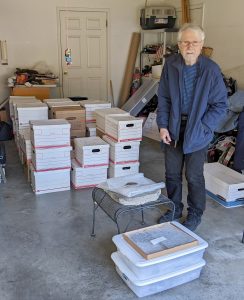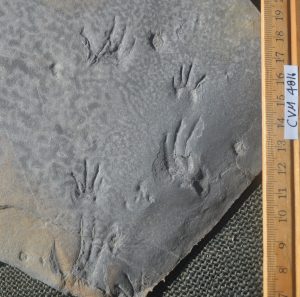
Trackways of ancient animals inhabiting a swampy area during the coal-age in what is now northern Alabama have been known for nearly a century, but they were nearly forgotten for a long time. The discovery of many ~315 million-year-old trackways in the Union Chapel Mine (Steven C. Minkin Paleozoic Footprint site) in Walker County in 1999 and subsequent trips spurred renewed interest and golden opportunities for research and education ongoing to the present day. But the Union Chapel Mine is not the only site.
In 2011, a new locality with many fossil footprints was discovered in Walker County by Dr. Ron Buta, prominent avocational paleontologist, UA Professor Emeritus of Astronomy, and Research Associate of Paleontology at the UA Museums. This Crescent Valley Mine has also yielded many trackways from ancient reptiles, amphibians, and invertebrates in addition to plant fossils, but from a more nearshore environment than the Union Chapel Mine. These two strip-mine sites have yielded many spectacular fossils of national and even international significance.

Ron singlehandedly collected over 5000 slabs from the Crescent Valley Mine, the majority of which previously was donated to museum collections, including the Alabama Museum of Natural History collection. On October 21, Ron donated the last 600 slabs he collected from January 2019 through May 2022 prior to the final reclamation of the Crescent Valley Mine. Ron, his wife Deb Crocker, and Dr. Adiel Klompmaker (UA Museums’ Curator of Paleontology) packed up the ~50 boxes and oversized specimens and transported them to the museum for further curation.
“We are very grateful to Ron for this new donation,” Dr. Klompmaker said. “His efforts to collect and preserve this many fossils from the Crescent Valley Mine are truly remarkable. These Alabama fossils will be very useful for scientific research in the short and long term, as well as for education and outreach.” In fact, the newly donated fossils as well as those donated before are already the subject of ongoing research by Ron. For this project, he has made 15,500 digital images of the specimens, all of which will eventually be publicly available through a website.